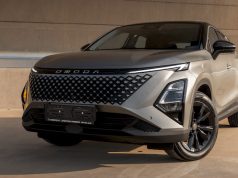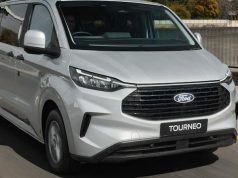The Volvo C40 P8 Recharge Twin, a powerful, fully electric compact crossover with all-wheel drive, is an exceptional entry into the world of eco-friendly automobiles. Volvo’s commitment to sustainability is evident in every aspect of this car, making it a serious contender in the growing electric vehicle (EV) market.
Main features of the Volvo C40 P8 Recharge Twin AWD Ultimate
- Real-world range of 300-350 km (444 km max. claimed)
- Sprints from 0 to 100 km/h in just 4,7 seconds
- All-wheel drive
- Fixed glass roof
- Android Auto and Apple CarPlay compatible
- Intellisafe Assist (includes City Safety with pedestrian, cyclist and large animal detection and front and rear collision warning with full auto brake)
- Seven airbags
- Home charging wallbox included
- Heated seats all round
- Two USB-C ports in the front and two in the rear
- Crash safety score: 5/5 (Euro NCAP test)
Exterior design
The Volvo C40 P8 Recharge Twin, based on Volvo’s XC40, boasts a sleek and contemporary design that sets it apart from conventional SUVs. Its coupé-like silhouette and refined lines give it an elegant and futuristic appeal, combining practicality with style. It’s a refreshing change, because many of these fastback or “coupé” SUVs look like a dog’s breakfast, but Volvo has pulled off its offering with great success.
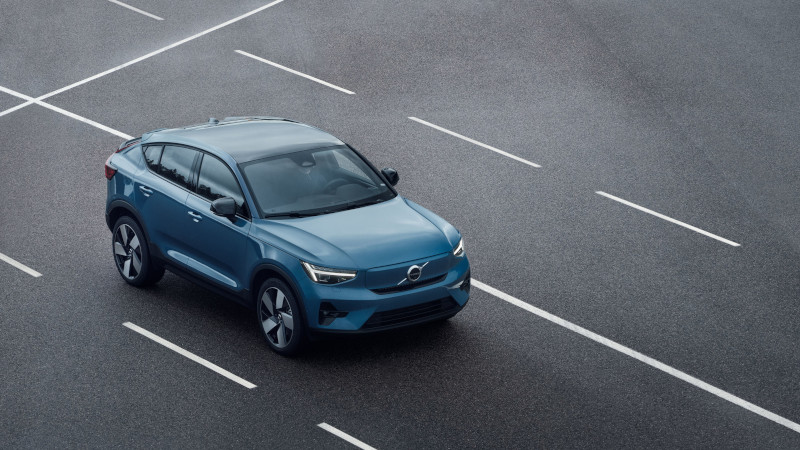
Lighting and vision
The LED lighting signature, a hallmark of modern Volvo vehicles, adds a touch of sophistication while enhancing visibility and safety on the road. However, we found that the sloping roof line and rearmost roof pillars limit the driver’s view to the rear. Especially dark window tinting made outward visibility even worse.
These traits are in contrast with Volvo’s well-earned reputation for safety, but the on-screen surround view, rear traffic alert (with braking), blind-spot warning, Lane Keep Assist are mitigating factors. LED headlights (with washers) come as standard. However, our test car was fitted with optional Pixel LED headlights (R24 200). These ensure that the headlights shine on either side of oncoming vehicles, not directly on them.
At 4,44 metres, the C40 P8 Recharge Twin is slightly longer than the XC40, and its roof line is a touch lower. The C40 P8 is similar in size to the Toyota Corolla Cross and Nissan Qashqai.
Interior comfort and technology
Step inside the Volvo C40 P8 Recharge Twin, and you are greeted by an inviting and up-scale interior. All the interior surfaces are black or charcoal in colour. The roof is a large, fixed piece of glass, very similar to that of the electric Jaguar I-Pace. Considering the cars size, the cabin offers ample space for passengers. The boot, which holds 489 litres, is about equal in size to that of the XC40. (There’s a 31 litre “frunk” under the bonnet, useful for stowing cables.)
The steering wheel and all the seats can be heated to keep the cold at bay. They’re comfortable, ensuring a great driving experience on short commutes and long journeys. The rear seats have power-folding headrests that the driver can instantly drop for improved rear visibility. The driver’s seat has electrically adjusted lumbar support. High-quality materials, soft-touch surfaces, and sustainable materials, such as recycled plastics and vegan upholstery (partial cloth and suede cloth), reduce the car’s environmental impact.
[mailchimp_list]
The technology on offer is comprehensive. The infotainment system, with Harmon Kardon sound, features a tall touchscreen interface that integrates with smartphone connectivity options. Unfortunately, it looks dated, and it is not user friendly. Too many functions, like controlling the air-conditioning, require diving into the menu. Volvo should include at least a handful of physical buttons, for example one that activates the air-conditioning’s recirculation mode. Another let-down was the rear ‘transmission tunnel’ which impedes the middle (rear) passenger’s legroom. The floor should really be flat, something most other EV makers manage to achieve.
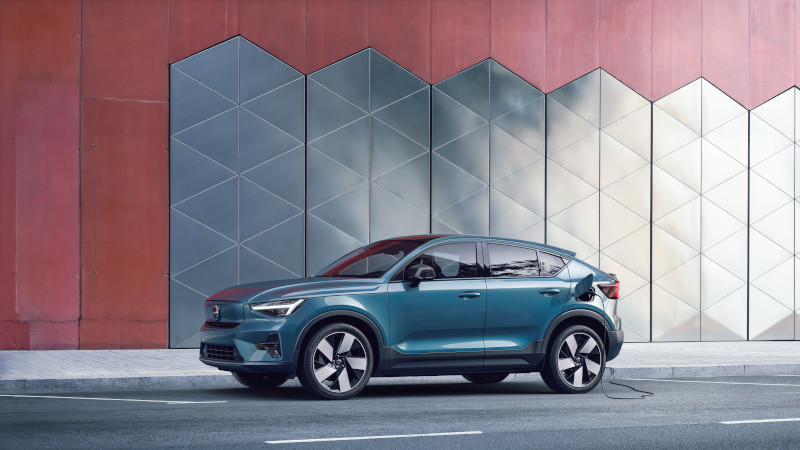
Performance and range
Underneath its attractive exterior, the C40 P8 Recharge Twin houses a formidable all-electric powertrain that puts out 300 kW and 660 Nm! Like the XC40 Recharge, the C40 has no start button. To engage Drive and get going, simply pull the gear lever towards you while pressing down on the brake pedal. Now it’s as simple as pressing down on the accelerator.
How does it drive?
The dual electric motors (hence the “Twin” suffix) deliver instant torque, providing a responsive and exciting driving experience. The acceleration is smooth and swift, making merging onto highways and overtaking effortless. The cabin is quiet at cruising speed.
There are two settings for battery regeneration. One allows the engine to coast like a petrol or diesel car, while the other uses the motors to slow the car down. The latter mode is often referred to as one-pedal driving, because it’s rarely necessary to use the brake pedal.

Suspension
Despite its sportscar-like sprinting ability (0-100 km/h in 4,7 seconds) the C40 Recharge Twin still strikes a fine balance between comfort and high performance. Unfortunately, it’s less efficient than BMW’s iX, iX3, and i4, and will require more frequent charging than an i4.
The suspension copes well with the C40 P8 Recharge Twin’s kerb weight of 2 185 kg (or two VW Polos). But, driving on a poorly maintained tar road causes a few jitters, which can be expected considering the burden of a very heavy battery pack. The test car wore 20” alloy wheels with low-profile tyres. Smaller wheels with more rubber could help the suspension to deal with that hefty battery.
The C40 P8 Recharge Twin is not designed for off-roading but driving it on reasonably smooth but twisty gravel roads is a joy. It’s immensely sure-footed, which made me feel like Stig Blomqvist piloting an early 80s Audi Quattro rally car in the snow. It’s interesting that the C40 P8 Recharge Twin has an impressive wading depth of almost half a metre. The car’s ground clearance of 171 mm is in line with other crossovers of its size.
If you have to tow a trailer at some stage, it’s good to know the C40 P8 Recharge Twin can manage 750 kg (unbraked) or 1 800 kg (braked).
Distance-to-empty
The C40 P8 Recharge Twin’s battery pack offers an unimpressive real-world range of around 320 km, but it is enough to enable practical daily driving without constant recharging. With access to fast-charging infrastructure, like that of GridCars or Rubicon, the 78 kWh battery can achieve an 80 percent charge in a conveniently short time, making it suitable for weekend trips or even longer…
However, in areas with limited charging infrastructure, long-distance travel planning will require careful consideration. The C40 P8 Recharge Twin’s highest possible rate of charge is 200 kW, but in South Africa you’ll be lucky to find an 80-kW charger.

Likes
- Exterior and interior design, solid build quality, and quality of cabin materials
- Overtaking acceleration
- Impressive safety features and all-wheel drive
- Road-holding on slippery surfaces
- Comprehensive list of included equipment
- Included wallbox home charger and cable for public AC chargers
- All-round heated seats
- Volvo on Call for five years
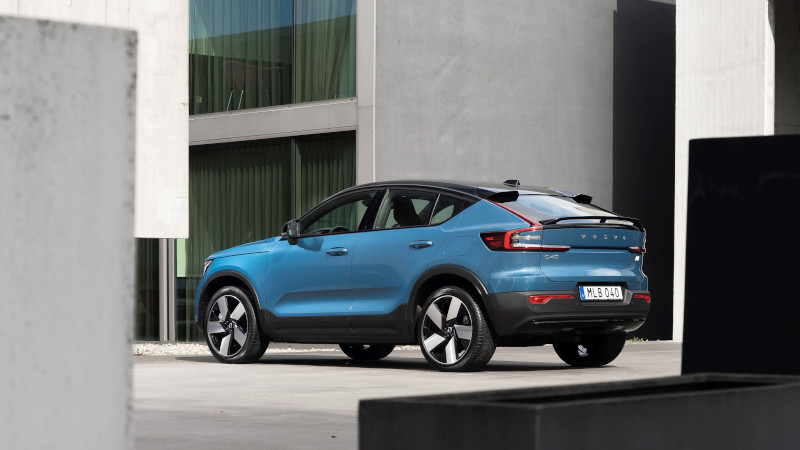
Dislikes
- The trip computer showed consumption of 28-29 kWh per 100 km. This is worse than the indicated 22-24 kWh per 100 km of the BMW iX xDrive 50 and Mercedes-Benz EQS 450+.
- Limited outward visibility because of overly dark window tinting and sloping roof
- The transmission tunnel in the rear passengers’ footwell
Conclusion
The Volvo C40 Recharge Twin is a striking step towards sustainable mobility, even when most of the electricity used for EV charging comes from coal-fired power stations. Combining elegant design, superior safety technology, impressive performance, and a commitment to eco-friendliness, the C40 Recharge Twin stands as a symbol of Volvo’s dedication to a cleaner, greener, and safer future.
While it may have some drawbacks, the overall package of luxury, comfort, and environmental consciousness makes the Volvo C40 Recharge Twin a compelling choice for environmentally-conscious drivers. Update: Volvo is changing the name of the C40 Recharge to EC 40 and dropping “Recharge”.
The Volvo C40 P8 Recharge Twin AWD Ultimate scores 4 out of 5.
4.0 out of 5.0 starsSpecifications
- Price: R1 285 000 (August 2023, without extras)
- Engine: Two electric motors
- Max. power: 300 kW
- Max. torque: 660 Nm
- Transmission: 1-speed
- Driven wheels: all
- Electric motor battery: 78 kWh (75 kWh usable)
- Range: 444 km (Volvo’s figure)
- Consumption: 22,3 – 19,8 kWh/100 km (Volvo’s figure)
- Unladen weight: 2 185 kg
- Luggage volume: 489 litres
- 0-100 km/h sprint: 4,7seconds
- Top speed: 180 km/h
- Warranty: 5-year or 100 000 km vehicle warranty and 8-year or 160 000 km battery warranty
- Maintenance: 5-year or 100 000 km full maintenance plan
- Also consider: BYD Atto 3, Volvo EX30, BMW iX1, BMW iX3, Mercedes-Benz EQB























